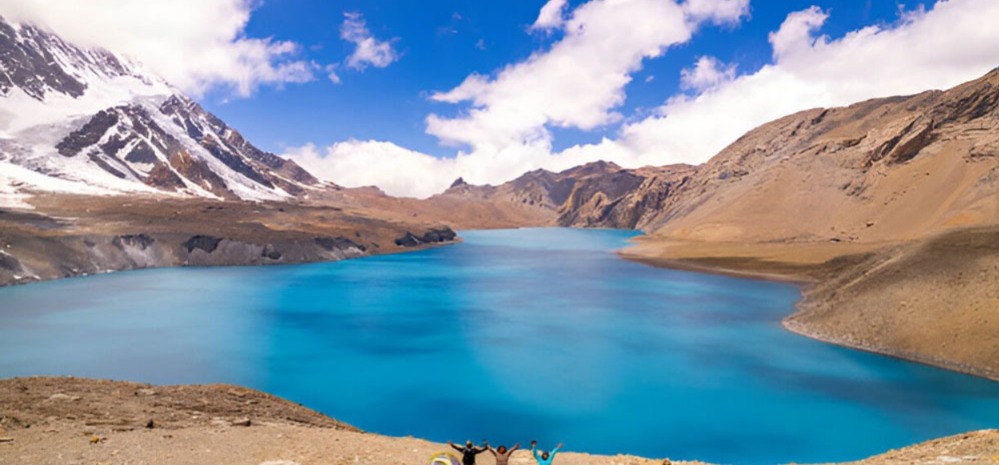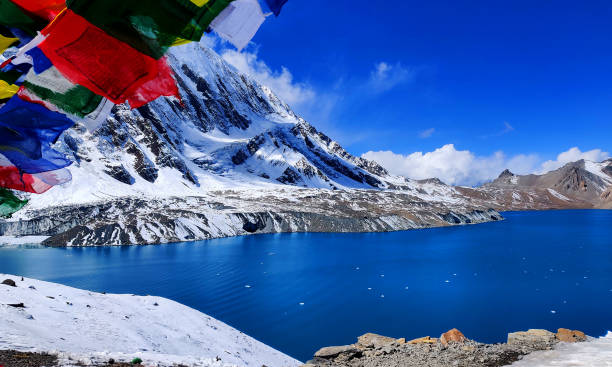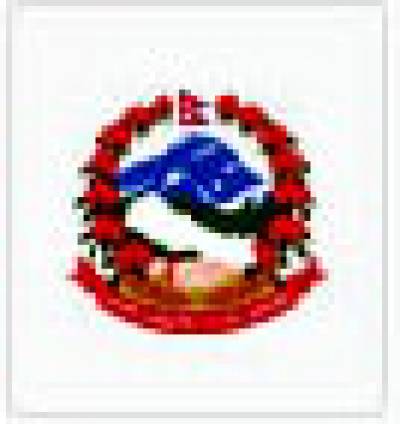ANNAPURNA CIRCUIT WITH TILICHO LAKE TREK 20 DAYS
The 20-Day Annapurna Circuit with Tilicho Lake Trek offers an extraordinary opportunity to explore the breathtaking landscapes, rich cultures, and majestic Himalayan peaks of Nepal's Annapurna region. Starting with your arrival in Kathmandu, the capital city, you’ll be transferred to your hotel for a restful night before embarking on your adventure.
On Day 2, you'll begin the journey with a scenic drive to Jagat, passing through lush valleys and picturesque landscapes. From there, your trek commences, gradually ascending through villages like Dharapani, Chame, and Pisang, before reaching Manang, where you'll spend a full day acclimatizing to the higher altitudes.
After acclimatization, you'll continue towards Shree Kharka, then climb up to Tilicho Base Camp, the gateway to Tilicho Lake (4,949m), which holds the title of the world’s highest lake. The visit to this stunning, high-altitude lake is a highlight of the trek, offering magnificent views of surrounding glaciers and towering peaks. Afterward, you’ll descend to Shree Kharka and continue to Yak Kharka and Thorong Phedi, setting the stage for the ascent of Thorong La Pass (5,416m), one of the highest trekking passes in the world. The pass offers dramatic views that make the challenging ascent worthwhile.
Once you’ve crossed Thorong La, you’ll descend to Muktinath, a sacred temple site significant to both Hindus and Buddhists. After spending time at the temple, the journey continues to Marpha, a traditional village famous for its apple orchards, before heading to Tatopani. Here, you can relax in natural hot springs to rejuvenate your muscles after days of trekking.
The trek then takes you towards Ghorepani, where an early-morning hike to Poon Hill will reward you with one of the best panoramic views of the Himalayas, including peaks like Annapurna and Dhaulagiri. After soaking in the views, the trek continues through charming villages like Tadapani and Ghandruk, giving you a glimpse of local culture and the beauty of the region.
Finally, after completing the trek, you’ll drive to Pokhara, a beautiful lakeside city, where you can unwind before returning to Kathmandu for your departure. This 20-day trek offers an unforgettable adventure, combining physical challenges, cultural experiences, and the spectacular beauty of the Annapurna range and Tilicho Lake.
ITINERARY
Day 1 : Arrival in Kathmandu and Transfer to Hotel.
Upon arrival in Kathmandu, you will be greeted by your guide and transferred to your hotel. Take the rest of the day to relax and explore the vibrant capital city at your leisure. Kathmandu is known for its bustling streets, ancient temples, and rich cultural heritage.
Day 2 : Drive from Kathmandu to Syange/Jagat (1,130m) via Besishahar – Duration: 8-9 hours.
After an early breakfast, you will embark on a scenic drive from Kathmandu to Syange/Jagat via Besishahar. Along the way, you will pass through lush valleys, small villages, and terraced fields as you make your way toward the starting point of the trek. The long drive gives you a glimpse of the local rural lifestyle before you begin your adventure.
Day 3 : Trek from Syange/Jagat to Dharapani (1,860m) – Duration: 5-6 hours.
The trekking starts today with a gradual ascent as you make your way from Syange/Jagat to Dharapani. You will walk through charming villages, cross suspension bridges, and enjoy views of the Annapurna range. The trail gradually climbs, leading you to Dharapani, where you’ll rest for the night in a teahouse.
Day 4 : Trek from Dharapani to Chame (2,650m) – Duration: 5-6 hours.
Today’s trek continues towards Chame, the district headquarters of Manang. You will trek through lush pine forests, cross suspension bridges, and pass through picturesque villages. As you climb, the views of Annapurna II and Lamjung Himal become more breathtaking.
Day 5 : Trek from Chame to Pisang (3,300m) – Duration: 5-6 hours.
Today, you will trek to Pisang, a village surrounded by tall peaks. The trail takes you through pine forests and along the river, offering stunning views of the mountains. Pisang is a peaceful village, and the surroundings provide great opportunities for photography and relaxation.
Day 6 : Trek from Pisang to Manang (3,500m) via Ngawal – Duration: 6-7 hours.
On this day, the trail takes you through beautiful forests and high-altitude pastures as you make your way towards the village of Ngawal. After passing through Ngawal, you’ll continue your trek to Manang, a charming village where you’ll spend the night. The stunning views of Annapurna III and Gangapurna will accompany you throughout the day.
Day 7 : Exploration and Acclimatization Day at Manang.
You will spend today in Manang for acclimatization. It’s important to take rest days during high-altitude treks to prevent altitude sickness. You can explore the village, visit local monasteries, and enjoy the panoramic views of the surrounding mountains. Optional short hikes are available for those wanting to stretch their legs.
Day 8 : Trek from Manang to Siri Kharka (4,060m) – Duration: 4-5 hours.
Today’s trek will take you through the remote and peaceful landscapes as you head to Siri Kharka. The trail ascends gradually, passing through alpine meadows and forests. The higher elevation provides a more rugged environment, offering a true sense of adventure.
Day 9 : Trek from Siri Kharka to Tilicho Base Camp (4,140m) – Duration: 5-6 hours.
The trek from Siri Kharka to Tilicho Base Camp will be a challenging yet rewarding day. As you gain elevation, the scenery becomes even more dramatic, with panoramic views of snow-capped peaks. Upon reaching the base camp, you’ll be greeted by the sight of the towering mountains around you.
Day 10 : Visit Tilicho Lake (4,949m) and Return to Siri Kharka – Duration: 5-6 hours.
Today is a highlight of the trek: a visit to Tilicho Lake, the highest lake in the world. The blue waters of the lake, surrounded by snow-capped peaks, provide one of the most breathtaking views of the trek. After spending time at the lake, you will descend back to Siri Kharka for the night.
Day 11 : Trek from Siri Kharka to Yak Kharka (4,040m) – Duration: 4-5 hours.
You will trek to Yak Kharka today, a small village situated at a higher altitude. The trail takes you through high-altitude pastures and rugged terrain. Along the way, you may encounter grazing yaks and enjoy distant views of the surrounding peaks.
Day 12 : Trek from Yak Kharka to Phedi or High Camp (4,600m) – Duration: 4-5 hours.
Today’s trek brings you to Phedi or High Camp, the base camp for crossing Thorong La Pass. This part of the trek offers stunning views of the surrounding peaks, and you will begin to feel the altitude as you approach your highest point of the journey.
Day 13 : Cross Thorong La Pass (5,416m) and Trek to Muktinath (3,400m) – Duration: 8-9 hours.
The day you’ve been waiting for: crossing Thorong La Pass. At 5,416 meters, it’s one of the highest trekking passes in the world. The trek to the top is tough but rewarding, with panoramic views of the surrounding peaks. After crossing the pass, you’ll descend to Muktinath, a sacred pilgrimage site.
Day 14 : Trek from Muktinath to Marpha (2,700m) via Jomsom – Duration: 5-6 hours.
Today, you will descend from Muktinath to Marpha, a beautiful village known for its apple orchards. The trail passes through Jomsom, where you can stop for a break and explore the town. Marpha is a peaceful village, and it’s an excellent place to rest and unwind.
Day 15 : Drive from Marpha to Tatopani (1,300m) – Duration: 5-6 hours.
You will take a scenic drive from Marpha to Tatopani, a town famous for its natural hot springs. After days of trekking, a relaxing soak in the hot springs will be a welcome treat for your muscles.
Day 16 : Trek from Tatopani to Ghorepani (2,870m) – Duration: 7-8 hours.
Today, you’ll trek towards Ghorepani, passing through dense forests and picturesque villages. The trail ascends gradually as you approach Ghorepani, which offers spectacular views of the Annapurna and Dhaulagiri mountain ranges.
Day 17 : Hike to Poon Hill (3,210m), Trek to Tadapani (2,630m) – Duration: 7-9 hours.
Early in the morning, you’ll hike to Poon Hill to witness one of the most iconic sunrises in the Himalayas. From the summit, you’ll see panoramic views of the Annapurna and Dhaulagiri ranges. Afterward, you’ll continue trekking to Tadapani, a village surrounded by lush forests.
Day 18 : Trek to Ghandruk then Drive to Pokhara – Duration: 7-8 hours.
The trek today takes you to Ghandruk, a beautiful Gurung village. After spending some time exploring Ghandruk, you will take a short drive to Pokhara, a beautiful lakeside city.
Day 19 : Drive from Pokhara to Kathmandu – Duration: 6-7 hours.
Today, you will return to Kathmandu by tourist bus. The drive offers scenic views of the countryside, giving you a final opportunity to take in the beauty of Nepal before heading back to the capital.
Day 20 : Transfer to the International Airport for Your Final Departure.
After an unforgettable journey, you will be transferred to the international airport for your departure. You’ll leave Nepal with incredible memories and experiences that will last a lifetime.
SERVICES
Cost Included In Your Package
- Airport pick-up and drop services on a private vehicle.
- 2 night’s hotel accommodation in Kathmandu with breakfast
- Kathmandu - Besisahar transfers on a local bus, Pokhara - Kathmandu transportation on a Tourist bus
- One night hotel accommodation in Pokhara with breakfast
- Marpha To Tatopani transportation on a Local Bus
- Ghandruk to Pokhara transportation by local bus
- Besisahar to Syange transfer on a Local sharing Jeep
- 3 Meals a Day [Breakfast, Lunch, and Dinner] during the trek
- Accommodation on beautiful cozy tea houses as per the itinerary
- Annapurna Conservation Area Project (ACAP) entry permits and Trekkers Information Management System (TIMS) cards
- Experienced English-speaking, government licensed and ministry of tourism trained trekking guide with meals, accommodation, salary and insurance
- Strong experienced Sherpa helpers [porters] with meals, accommodation, salary, and insurance
- Arrangement of emergency helicopter service (paid by your Travel Insurance Company).
- Use of sleeping bag, down jacket, duffel bag and walking poles (if you don’t have your own, to be returned after trip completed).
- Comprehensive first aid medical kit carried by the guide / American medical association approved Oximeter
- Sherpa Expedition and Trekking T-shirt
- Trip achievement certificate after successful trip completion.
- Oxygen meter to check your pulse and oxygen saturation and heart rate twice daily (Very useful to check Altitude Mountain Sickness(AMS) symptoms) which will ensure your health during the trek.
- Assistant guide for groups of 8 or more people.
Costs Exclude
- Meals whilst you are in Kathmandu & Pokhara - lunch, and dinner.
- Nepal entry visa fee (easy to obtain the visa on arrival at Tribhuvan International Airport – Kathmandu). $30 USD for 15-day, $50 USD for 30 Days, and $125 USD for 90 Days visa.
- Personal travel and medical insurance.
- International airfare.
- Your personal expenses.
- All the alcoholic and nonalcoholic, soup, tea, coffee, hot chocolate, cocoa, mineral water, extra food, cold and hot drinks on trek ( i.e. those you choose to purchase along the way and during evenings in the tea houses)
- All desserts & sweet things like chocolate, cake, pie, pudding.
- Hot shower and battery charging at the tea houses.
- Tips for the guide, porter, and driver (tipping is expected)
- NOTE: If you return earlier from the trek due to sickness or any problem, the money you paid for the flight, hotel, mountain room, food, etc. is nonrefundable, and you will need to bear the expenses for the hotel, food, etc. in Kathmandu yourself.
EQUIPMENTS
The following information will give you some idea about what you need to bring for the trek. It is important you do not forget the essential items, as this will determine your comfort and safety on the trek. Equally important is that you do not burden yourself with unnecessary equipment on the trek.
- Sleeping Bag (Sherpa Teams will provide but need to return after completing the trip)
- Duffel Bag (Sherpa Teams will provide but need to return after completing the trip)
- Fleece jacket or pullover
- Waterproof windbreaker or windcheater
- Thermal underclothes
- Rain poncho
- Down jacket (Sherpa Teams will provide but need to return after completing the trip)
- Fleece or wool trousers
- Sun hat or scarf
- Trekking pants (two pairs)
- Mittens or woolen gloves
- Hiking socks (several pairs)
- Moisture-wicking shirts, including t-shirts
- Trekking shoes or boots with spare laces
- Flip-flops or sandals for relaxing in the evenings
- Underwear (several pairs)
- Swimsuit or swimming costume
- Sunglasses
- Headlamp or flashlight/torch
- Sleeping bag (Sherpa Teams can provide this for you)
- Trekking poles (if desired)
- Hiking backpack with a capacity of at least 40 liters
- Small lock for your backpack
- Reusable water bottles (at least two liters)
- Water purification tablets or filtration device
- Wash towel
- Basic first aid kit
Toiletries (tissues, toilet paper, moisturizer, lip balm, sunscreen, sanitary pads, hand sanitizer, nail clippers, a small mirror, toothbrush, toothpaste, glasses, contacts, etc.)
GOOD TO KNOW
🛂 Travel Permits & Documentation
Essential Trekking Permits
For the Annapurna Circuit with Tilicho Lake Trek, you will need two essential permits: the Annapurna Conservation Area Permit (ACAP) and the TIMS (Trekkers' Information Management System) Card. These permits ensure that trekkers are registered for safety purposes and help maintain the conservation of the Annapurna region. They can be obtained in Kathmandu or through a local trekking agency.
🌤️ Weather & Best Time to Trek
Ideal Trekking Seasons
The best times to trek in the Annapurna region are during Spring (March to May) and Autumn (September to November). During these months, you can expect clear skies, mild temperatures, and optimal trekking conditions. Winters can be extremely cold, and the monsoon season (June to August) often brings heavy rainfall, which can make trails slippery.
💪 Fitness & Preparation
Physical Preparation
While the trek is suitable for most trekkers, good physical fitness is recommended. Cardiovascular exercises (like hiking, cycling, or running) and strength training can help prepare you for the challenging days ahead. Train for 4-6 weeks prior to your trek, focusing on endurance and leg strength, as well as your stamina.
🏡 Teahouses & Accommodation
Lodging During the Trek
Throughout the trek, you’ll stay in teahouses (small guesthouses). These basic accommodations offer a cozy bed and simple meals. As you ascend to higher altitudes, the facilities may become more basic, but the warmth and hospitality of the local people remain consistent. Bring a sleeping bag to ensure extra comfort at higher altitudes.
🥘 Food & Water
Meals on the Trail
Meals on the trek are typically provided at the teahouses. Expect a variety of Nepali and international foods such as dal bhat, noodles, momos, and fried rice. As you progress higher, the menu may become simpler. Bring some energy snacks (bars, nuts, etc.) for quick boosts during long trekking days.
🧳 Packing Tips
Essential Gear
Pack light, but ensure that you bring the essentials: good trekking boots, a rain jacket, warm clothes for higher altitudes, and a headlamp for early starts. A first aid kit, sunscreen, and water purification tablets are also important items to carry for safety and convenience.
🌍 Cultural Awareness
Respect Local Culture
The Annapurna region is rich in cultural diversity, with various ethnic groups, such as Gurungs, Tamang, and Tibetan communities. Be mindful of local customs, respect religious practices, and always ask permission before taking photos of people, especially in villages.
MAP
PHOTOS/Videos
Departures
Select a departure month
Fill out the form below and a Travel Expert will reach out to create your perfect tour.
FAQS
What is the best time to trek the Annapurna Circuit with Tilicho Lake?
The best time to trek the Annapurna Circuit with Tilicho Lake is during Spring (March to May) and Autumn (September to November). These seasons offer mild weather, clear skies, and optimal trekking conditions.
How difficult is the Annapurna Circuit with Tilicho Lake Trek?
The trek is considered moderate to challenging due to the high altitudes and long trekking days. It requires good physical fitness, as you will be trekking for 5-8 hours per day and crossing the Thorong La Pass at an altitude of 5,416 meters.
What permits are required for the trek?
You will need two main permits for the Annapurna Circuit: the Annapurna Conservation Area Permit (ACAP) and the TIMS (Trekkers' Information Management System) Card. These can be obtained in Kathmandu or through a trekking agency.
Is it safe to trek alone?
While trekking in a group is recommended for safety reasons, many trekkers do go solo. However, if you choose to trek alone, it’s essential to stay connected with a guide or porter, or inform local authorities of your itinerary for safety purposes.
How can I prepare for the altitude?
Acclimatization is crucial to prevent altitude sickness. The trek is designed with rest days at higher altitudes, like Manang, to allow your body to adjust. Make sure to stay hydrated, avoid overexertion, and recognize the symptoms of altitude sickness (headaches, dizziness, nausea).
What type of accommodation can I expect during the trek?
The trek offers basic teahouse accommodations along the route. These guesthouses provide a bed, food, and shelter. The facilities are more basic as you go higher, but they are adequate for the trek.
How should I prepare for the weather conditions?
The weather can be unpredictable, especially at higher altitudes. Make sure to bring warm clothing (layers are best), a rain jacket, and appropriate trekking boots. Prepare for cold nights and varying weather patterns.
What kind of food will I get during the trek?
Teahouses along the route typically serve Nepali and international dishes like dal bhat, momos, noodles, and fried rice. As you ascend, the variety may become simpler, but most places offer vegetarian meals to cater to all trekkers.
Can I get drinking water during the trek?
Yes, water is available at teahouses along the route, but it’s safer to purify it using water purification tablets or a filter. You can also buy bottled water, but it’s a more expensive and environmentally harmful option.
How long does the trek take?
The Annapurna Circuit with Tilicho Lake Trek typically takes 19 to 20 days, depending on the specific itinerary. The trek includes acclimatization days and the challenging climb over Thorong La Pass.
Latest Traveller’s Reviews
Travel experiences of our clients who recently returned from their trips.
100%
Based On 5470 Reviews
Emily Zhao
Singapore
May 28, 2025
Professional Trek, Heartfelt Memories – Led by Tshering
I signed up for the Annapurna Base Camp trek with Sherpa Expedition based on a friend’s recommendation, and now I can confidently say it was the best travel decision I’ve ever made. Our guide, Tshering, was truly special. Calm, experienced, and incredibly warm-hearted, he guided us through every step with confidence and care. What I admired most was how he made sure everyone in the group felt supported. Whether it was helping with altitude or simply offering a kind word during steep climbs, he was always there. The trek itself was stunning—every day revealed a new landscape and view. We trekked through rhododendron forests, past rivers and waterfalls, and finally reached the snow-filled amphitheater of Annapurna Base Camp. Sherpa Expedition managed all logistics perfectly—from flights to accommodation to delicious meals at the tea houses. Tshering taught us about the culture, pointed out peaks, and even made us laugh during the tough sections. The views from base camp were beyond anything I’ve ever seen—pure magic. I left Nepal with new friendships and a heart full of gratitude. Thank you, Tshering, and thank you, Sherpa Expedition, for an unforgettable experience.
Laura Petrovic
Canada
May 13, 2025
Absolutely Magical Trek with Guide Dendi
Trekking to Annapurna Base Camp was one of the most magical experiences of my life. Sherpa Expedition made the entire journey smooth and stress-free, and a huge part of that was thanks to our guide, Dendi. His professionalism, combined with his kindness, made him the perfect companion for this adventure. Dendi was extremely knowledgeable and knew the region inside out—he explained the culture, the peaks, and ensured we were adjusting well to the altitude. Every day was an adventure—crossing rivers, walking through thick forest trails, and climbing toward snow-covered landscapes. Sherpa Expedition’s planning was excellent. The flight from Kathmandu to Pokhara was on time, the porters were friendly and hardworking, and the tea houses we stayed in were comfortable and offered surprisingly good food. Dendi checked our health daily, helped with gear issues, and created a supportive group atmosphere. When we finally reached base camp, the sheer beauty brought tears to my eyes. It felt like standing in the heart of nature. This was not just a trek, but an emotional and beautiful journey. I’m thankful to Dendi and the Sherpa Expedition team. I would absolutely recommend this company for anyone looking to experience the Himalayas.
Marcel Mastenbroek
Netherlands
April 9, 2025
Beautiful adventure
My brother and I had a great trip to the Everest Base Camp. Together with Santa our very well informed gide, who took care of us in a fantastic way and gave us much information during the hike, and Gulzen our porter (who carried each day our two bags of 10kg each plus his own bag....unbelievable). We had a wonderful time in the beautiful Himalayas, it was a lifetime experience!
People Considering This Package Right Now Check availability
























